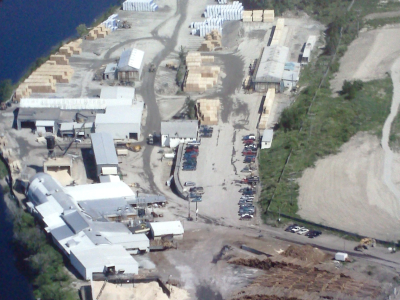Eacom Timber Corp. is rebuilding its Timmins sawmill after a fire destroyed part of the mill in January.
“We were left with half a mill,” said Brian Nicks, senior vice-president of forest operations. “Now we are in a position to rebuild and it is just a matter of cleaning up the the site, dealing with the insurance company and assessing the damage, and us deciding on what kind of equipment we want to put in.”
The fire destroyed the main saw line area which included the major saw, the debarking area and the primary break-down area.
One part of the mill was spared, along with a lot of equipment, that included edgers, trimmers, a planer, dry kiln, sorter and stacker.
“The area that was spared has about the same amount of value of what was destroyed in the mill,” he said.
That part of the plant remained operational and the company was bringing in rough lumber from its Gogama area mill to keep part of its Timmins workforce employed.
“The rough lumber that was brought into Timmins was put through the dry kiln and then fed through the planer. That kept some people working for sure,” Nicks said.
The plant had a staff of about 120 prior to the fire and about 80 per cent were still employed following the blaze. In July, the workforce was cut by 50 per cent since the importation of the wood was winding down in anticipation of the rebuilding.
“Bringing in the wood was fairly costly but we were doing it to respond to our customers,” he said. “Timmins was our top performing mill in terms of recovery and quality of wood.”
The mill saws larger diameter material which produces bigger and wider boards that are of higher value. It is twinned with the Gogama operation which is a small-log facility.
“The fire was definitely a noticeable hit to the business so we compensated for that by stepping up operations at Nairn Centre by adding another shift,” Nicks said. “We were also able to keep our bush contractors because there are more jobs involved in woodland operations than in sawmills. You can take the number of sawmill jobs and double that for our independent bush contractors. But we have kept them occupied in harvesting for other locations and other species.”
The rebuilding process will begin with removing the burnt equipment and undertaking the site preparation work. Once the new equipment is installed, it will have to be calibrated. The electrical system in that area was heavily damaged by water during firefighting efforts and rewiring will have to be done.
“We want to be in a position to reopen in May of next year,” he said. “We are expecting the housing market to recover more. It's a cyclical business and over the course of a year, prices tend to rise in the spring, peak out over the summer and decline in the fall and early winter.
“We want to be back and fully in action in Timmins and take advantage of what we hope will be a rising market once again.”
The mill is the only remaining one of three major sawmills that once operated in the city. Grant Forest Products' OSB plant has been dismantled and Tembec's sawmill has been idled for about five years. A smaller sawmill, Little John Enterprises, still operates in Timmins.
“We also have a sustainable wood supply for our mill and it is about 550,000 cubic metres per year of Crown timber committted to us,” Nicks said. “The government has been patient as well and reserved it for us in expectation of the rebuild. It's an opportunity to rebuild a reasonably old mill.”
The provincial forest industry, and Eacom, are well positioned, he said, in light of the mountain pine beetle devastation to the B.C. pine forests.
“That is creating a hole in the national production of softwood lumber and B.C. is shipping increasing amounts of wood to China,” he said.
Coupled with the sawmill shutdowns in Ontario and Quebec, some of which are permanent, Nicks said the recovery of the housing market will lead to log and lumber supplies tightening and pricing will reflect that.
“If you are an optimist and willing to invest and be patient, we think the rewards will be there for lumber companies in Ontario. That is why we are here and why we bought the sawmill operations of Domtar two years ago because we believe in that story.”




